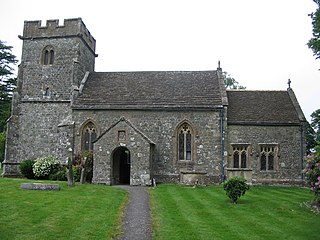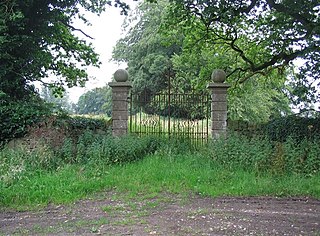Baron Blackford, of Compton Pauncefoot in the County of Somerset, was a title in the Peerage of the United Kingdom. It was created in 1935 for the politician, public servant and magistrate Sir William Mason, 1st Baronet. He had already been created a Baronet, of Compton Pauncefoot in the County Somerset, in the Baronetage of the United Kingdom in 1918. He was succeeded by his son, the second Baron. He was a businessman and Conservative politician. The titles became extinct in 1988 on the early death of his grandson, the fourth Baron.

Charlton Musgrove is a village and civil parish in Somerset, England, situated 1 mile (1.6 km) north east of Wincanton in the South Somerset district. The village has a population of 398. The parish includes the hamlets of Barrow, Holbrook, Southmarsh, and part of Shalford.

Horsington is a village and parish in Somerset, England, situated 4 miles (6.4 km) south of Wincanton and 1 mile (1.6 km) north of Templecombe in the South Somerset district. The village lies on the edge of Horsington Marsh, part of the Blackmore Vale. In 2011 the population of the Parish, which includes the adjoining hamlets of Peckholdsash and Wilkin Throop and the village of South Cheriton was 571.

Penselwood is a village and civil parish in the English county of Somerset. It is located 4 miles (6.4 km) north east of Wincanton, 4 miles (6.4 km) south east of Bruton, 4 miles (6.4 km) west of Mere, and 5 miles (8.0 km) north west of Gillingham. The south-east of the parish borders Zeals and Stourhead in Wiltshire, and Bourton in Dorset. In 1991 the parish occupied 523 hectares.

Yarlington is a village and civil parish, near the source of the River Cam, in the English county of Somerset.

Pitcombe is a village and civil parish 1 mile (2 km) south-west of Bruton and 5 miles (8 km) from Wincanton in Somerset, England. It has a population of 532. The parish includes the hamlets of Cole and Godminster.

The Church of St Mary in Rimpton, Somerset, England was built in the early 13th century and has been designated as a Grade I listed building.

Shanks House in Cucklington, Somerset, England is a Grade I listed building.

The Dogs in Wincanton, Somerset, England was built around 1650 and has been designated as a Grade I listed building.
Yenston Priory was a Benedictine priory in Henstridge, Somerset, England.
The Hundred of Horethorne is one of the 40 historical Hundreds in the historic county of Somerset, England, dating from before the Norman conquest during the Anglo-Saxon era although exact dates are unknown. Each hundred had a 'fyrd', which acted as the local defence force and a court which was responsible for the maintenance of the frankpledge system. They also formed a unit for the collection of taxes. The role of the hundred court was described in the Dooms (laws) of King Edgar. The name of the hundred was normally that of its meeting-place.
The Hundred of Norton Ferris is one of the 40 historical Hundreds in the ceremonial county of Somerset, England, dating from before the Norman conquest during the Anglo-Saxon era, although exact dates are unknown. Each hundred had a 'fyrd', which acted as the local defence force and a court which was responsible for the maintenance of the frankpledge system. They also formed a unit for the collection of taxes. The role of the hundred court was described in the Dooms (laws) of King Edgar. The name of the hundred was normally that of its meeting-place.
The Somerset Victoria County History is an encyclopaedic history of the county of Somerset in England, forming part of the overall Victoria County History of England founded in 1899 in honour of Queen Victoria. With ten volumes published in the series A History of the County of Somerset, the Somerset VCH is among the most substantial of the Victoria County Histories.

The Yarlington Wassail is a Wassail held in the village of Yarlington, Somerset, England, and dating from the 17th century.

The Anglican Church of St Mary at Templecombe, within the English county of Somerset, was built in the 12th century and is a Grade II* listed building.

The Anglican Church Of St Mary and St John in Upton Noble, within the English county of Somerset, was built in the 12th century. It is a Grade II* listed building.

The Anglican Church of St Mary in Yarlington, Somerset, England was built in the 11th century. It is a Grade II* listed building.

The Anglican Church of St John the Baptist in Horsington, Somerset, England was built in the 15th century and rebuilt between 1885 and 1887. It is a Grade II* listed building.

The Church of St Nicholas in Henstridge, Somerset, England was built in the 12th century. It is a Grade II* listed building.

The Anglican Church of St Peter and St Paul in Charlton Horethorne, Somerset, England was built in the 12th century. It is a Grade II* listed building.














